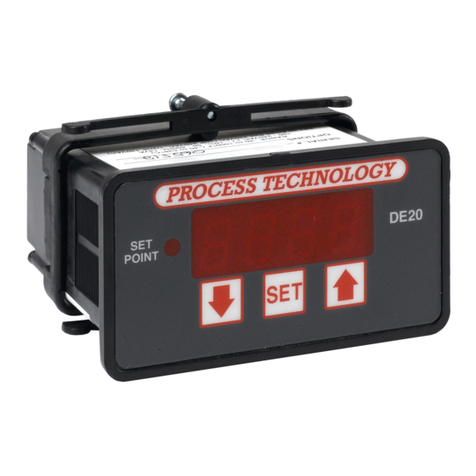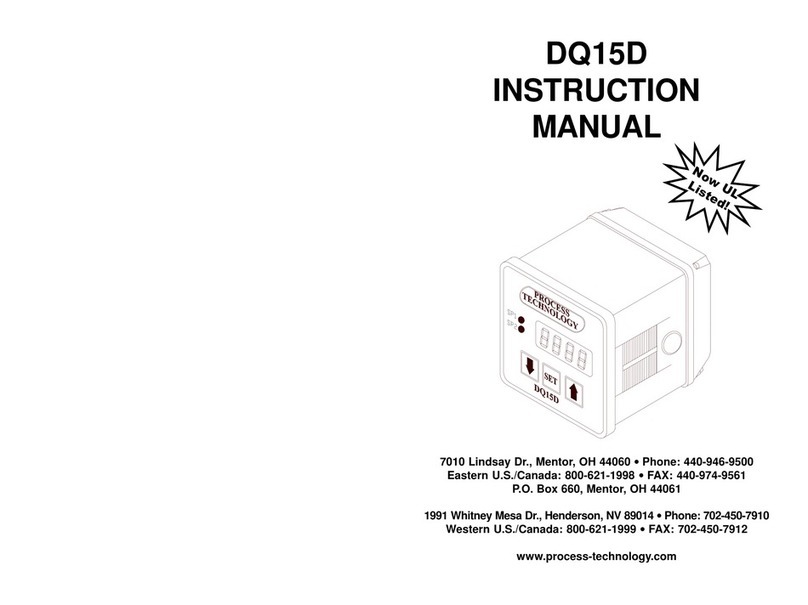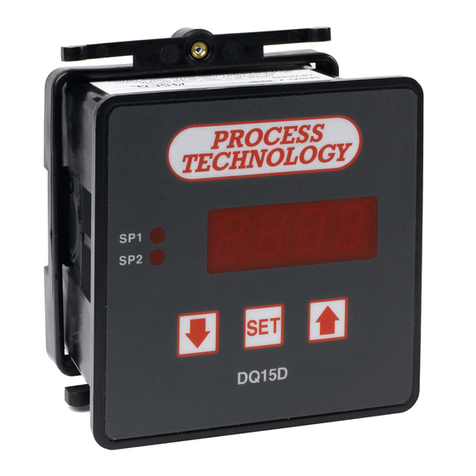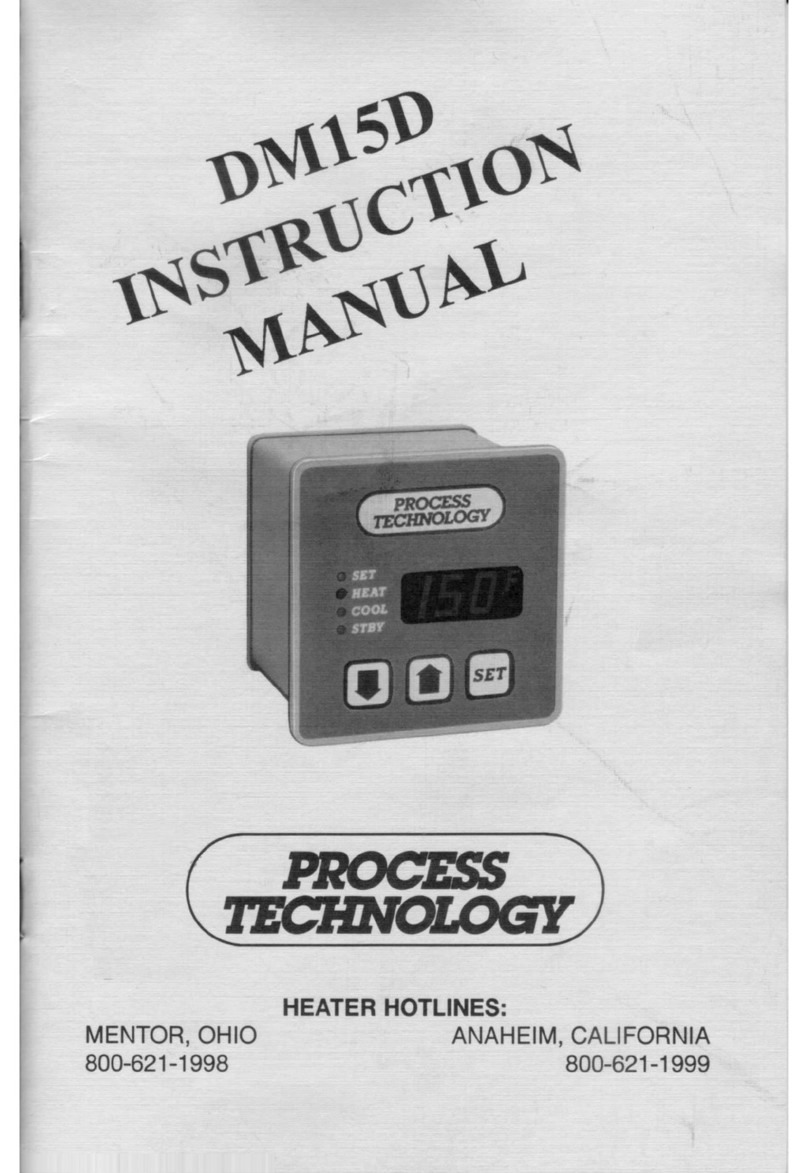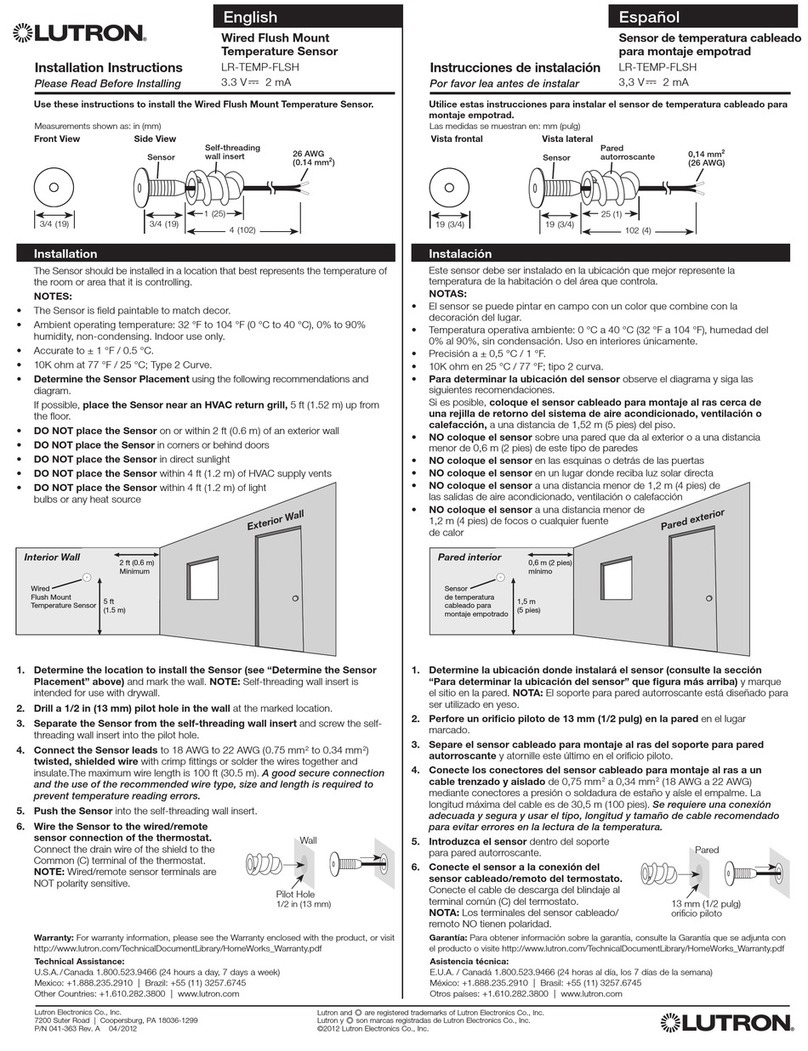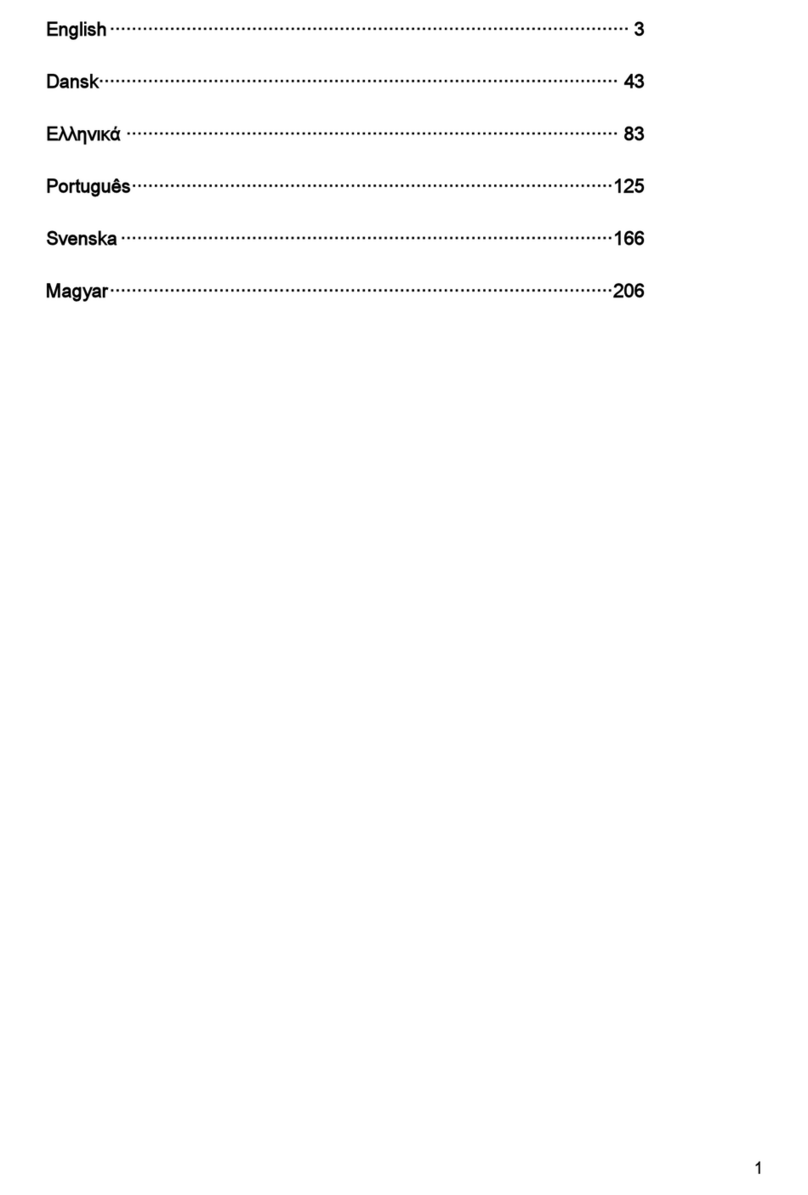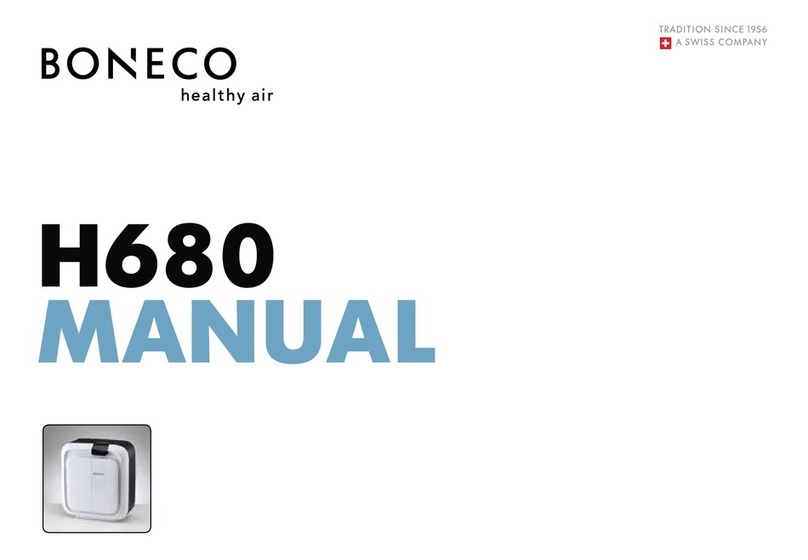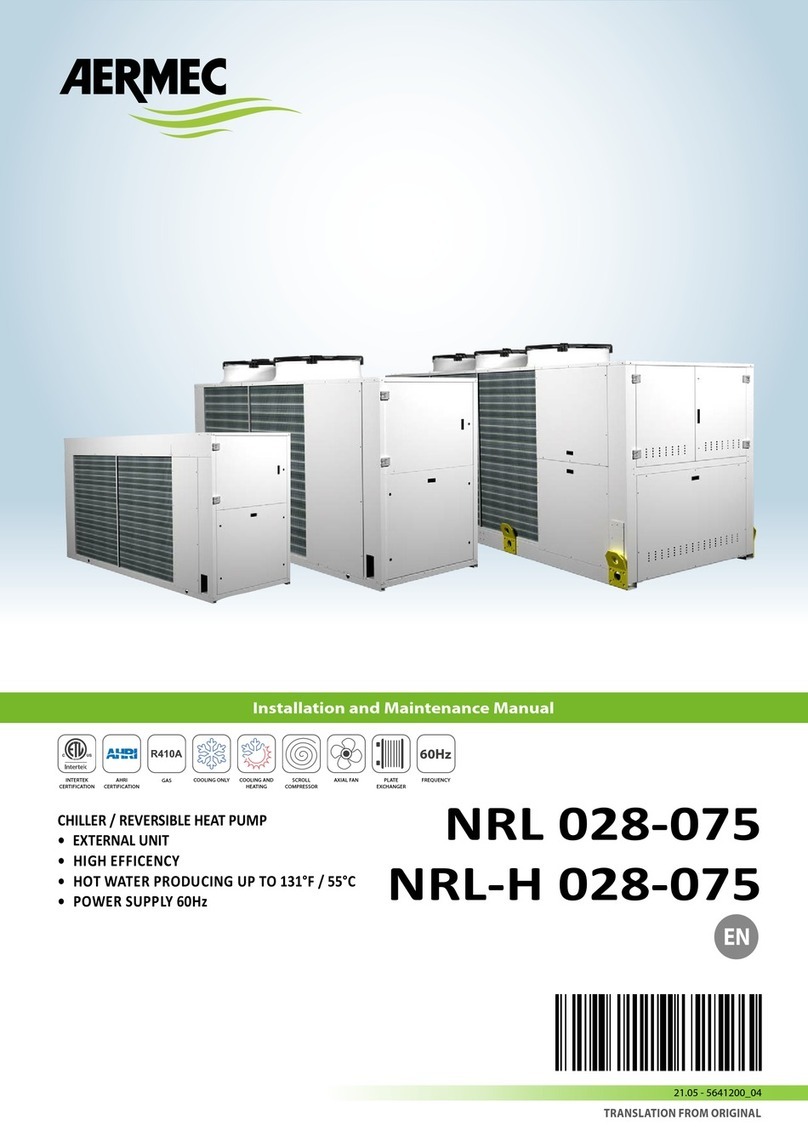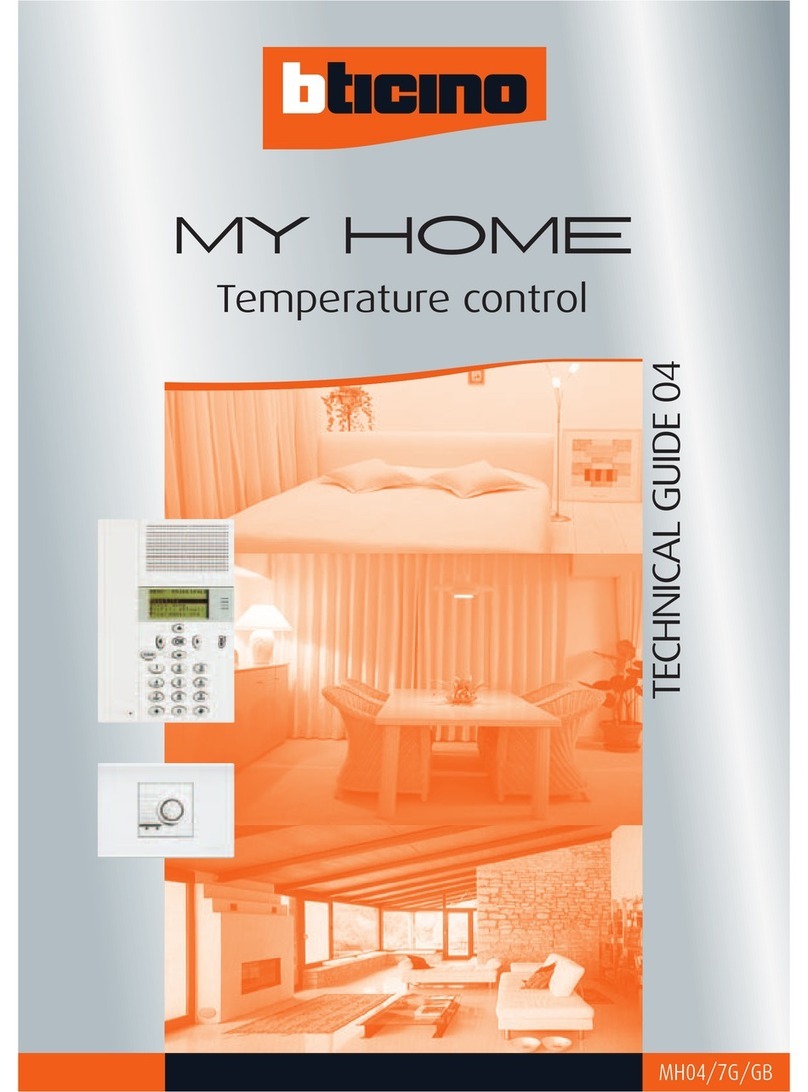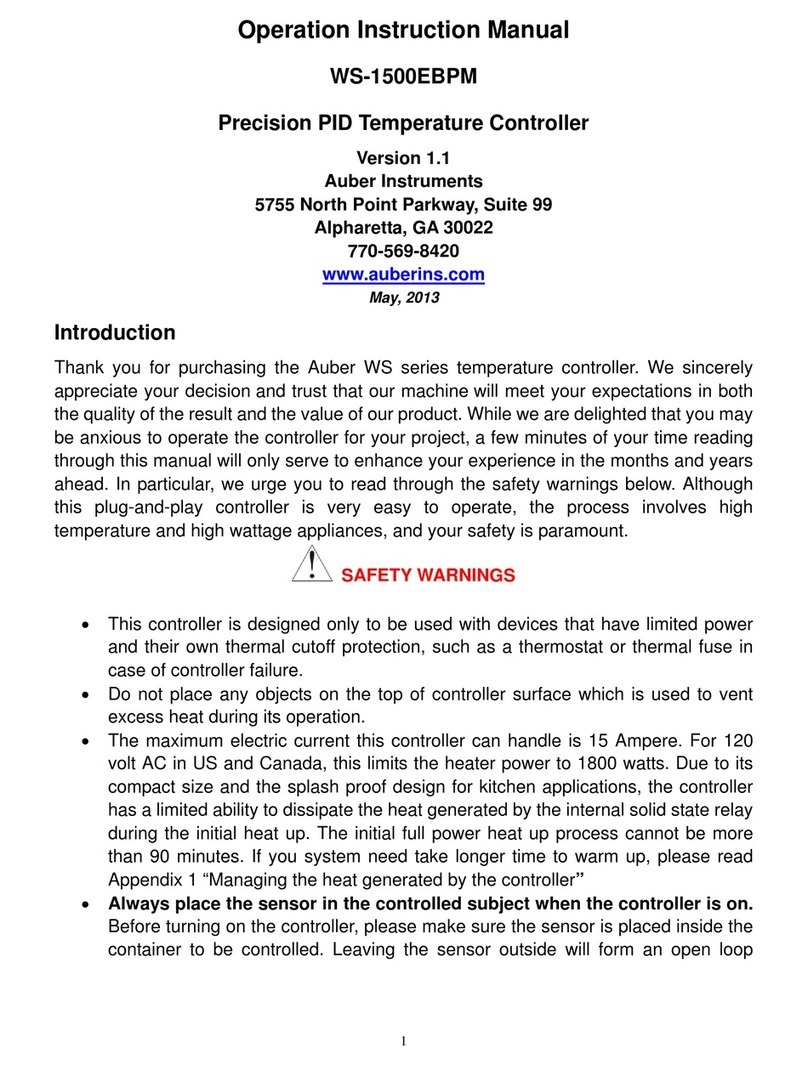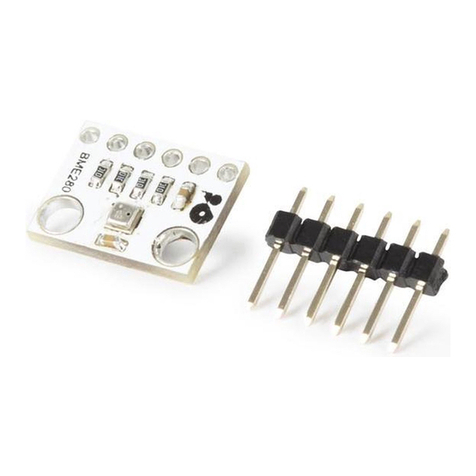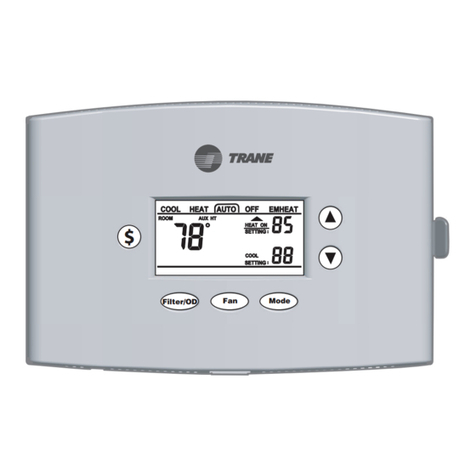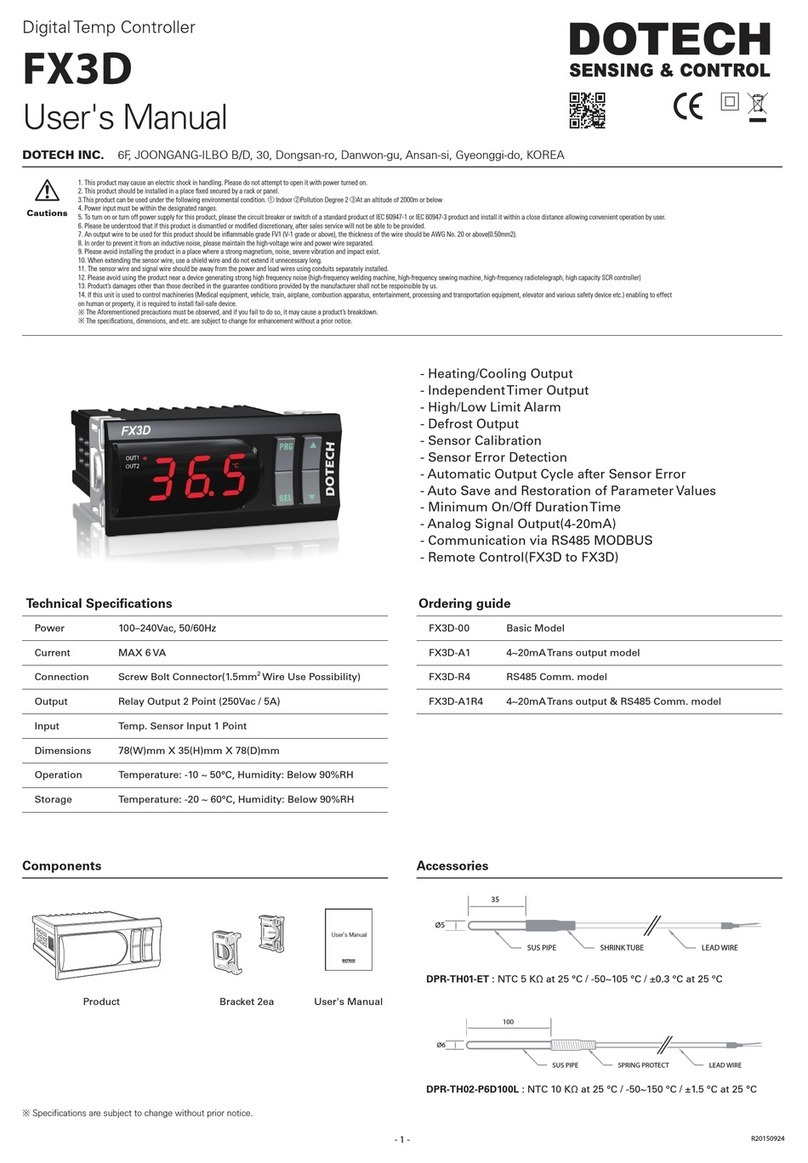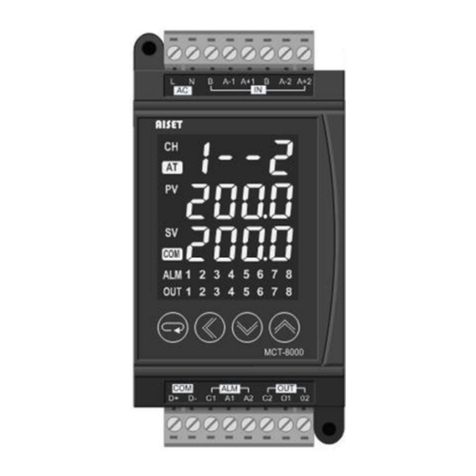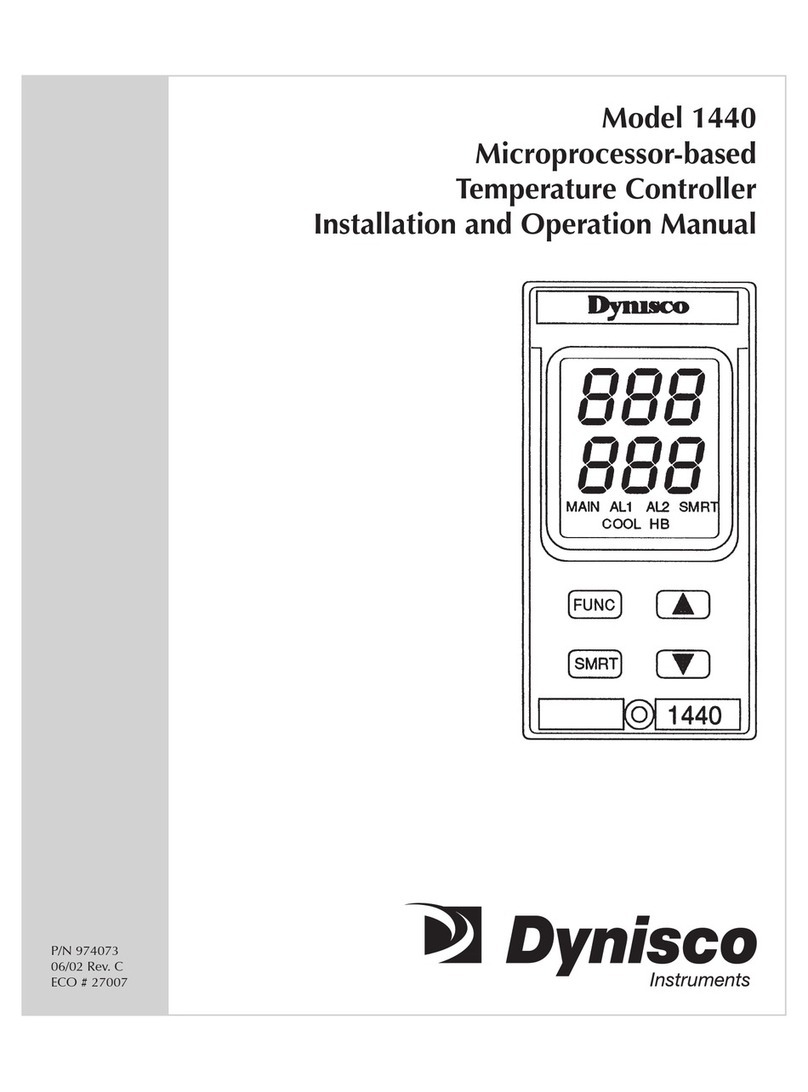Process Technology DQ15D User manual

Specifications ..................................................................1
GeneralDescription.........................................................2
Installation..................................................................2
Over-temperatureProtection.............................................................3
PowerandRelayWiring....................................................................4
SetPoint&Features...........................................................................4
AlarmFeature......................................................................................5
Calibration.............................................................................................5
2WireRTDSensorCalibration........................................................6
3WireRTDCalibration......................................................................7
ResistanceSignalCalibration...........................................................8
VoltageSignalCalibration..................................................................9
CurrentInputCalibration.................................................................10
FrequencySignalCalibration.........................................................10
ThermocoupleCalibration..............................................................11
4-20mAProcessOutput(Optional).............................................. 12
ErrorConditions................................................................................13
ErrorMessages................................................................................13
Configuration(Setup).......................................................................14
MainMenuSummary......................................................................15
SensorType(U1).............................................................................15
SignalOffset(U2).............................................................................16
OutputSignalOffset(U3)................................................................16
SignalFilterSetting(U4)..................................................................16
SetPoint1 DeadBand(U5)...........................................................16
SetPoint2DeadBand(U6)...........................................................17
PowerSaveSetPointDeadBand(U7)......................................17
DisplayStabilizer(U8)......................................................................17
SetPointLimit(L)..............................................................................17
SP2andU7Disable(F1)................................................................18
AlarmOn/OffSwitch(F3)................................................................18
UnitDisplayEnable(F4).................................................................18
TemperatureUnitsConversion(F5).............................................18
CurrentOutputEnable(F6)............................................................18
SensorDIPSwitchSettings...........................................................19
ElectricalNoiseandInterference...................................................20
IllustrationofaTypicalHeater
InstallationinaProcessTank.........................................................20
7010 Lindsay Drive •Mentor, Ohio 44060 •Phone: 440-974-1300
USA/CN: 800-621-1998 •Fax: 440-974-9561 •www
.processtechnolog
y.com
COPYRIGHT 2016 Process Technology
DQ15D/ T-DQ15D Instruction Manual
TABLE OF C
O
N
T
EN
TS
DQ15D / T-DQ15D Digital Temperature
Control

M-34-01-06 3/31/2016 1 DQ15D/T-DQ15D Manual
DQ15D Specifications
Standard Input
2 wire1000 ohm RTD TCR (alpha),
0.00385 ohm/ohm/°C
RTD Self Heating Coefficient:
5° C/w in 0.2 m/s water; 200° C/w in
1 m/s air measurement current, 0.1 to 0.2 mA
Input Range
-40°F (-40°C) to 1000°F (538°C); °F or °C field selectable
Set Point Range
Selectable throughout the input range
Sensor Break or
Short Protection
De-energize control output (No sensor short
protection with Thermocouple sensor)
Accuracy
± 0.25% span, ± 1 digit
Enclosure
Type 12, IP54
Face suitable for panel mounting (#20 ga. through 1/4 thick panels)
Display
4 digit, (1/2" nominal), LED display screen
Control Function
ON/OFF Electromechanical Relays
Control Outputs
SP1 Set Point
(reverse acting) SPDT 20A resistive@240 VAC max
1HP@240 VAC max, 1/2 HP@120VAC
SP2 Set Point
(direct acting) SPDT 2A resistive@240 VAC max
1/10HP@240 VAC max, 1/20 HP@120VAC
ON/OFF Differential
Field adjustable, 1° (F or C) to 99°
Memory
Nonvolatile
Supply Voltage
85 to 265 VAC, 50-60 Hz, 13VA
Operating Conditions
• Indoor Use Only
• 20°F (-7°C) to 140°F (60°C)
• Max Altitude: 3000m
• Max Relative Humidity: 80%
• Pollution Degree 2
• Installation Category II
Input Options
RTD 2 & 3-wire 100 ohm 0.00385 ohm/ohm/ºC or
0.00392 ohm/ohm/ºC
Thermocouples - (types J, K, T, R)
NIST Monograph 175, revision ITS-90 (Obsolete)
Current 4-20mA DC
Voltage (1-10 VDC)
Frequency (0-200 Hz, counts/second),
+/- 6 VDC p to p (up to 30VDC peak with Sw2 ON)
Output Options
4-20 mA DC proportional to the process (display) value.
Maximum impedance 450 Ohms.
EquipmentprotectedthroughoutbyDoubleInsulationorReinforcedInsulation.

M-34-01-06 3/31/2016 2 DQ15D/T-DQ15D Manual
General Descriptio
n
The DQ15D digital temperature control is a pro-
grammable and microprocessor based device
that operates two relays for temperature control.
Features
The temperature sensor (RTD or thermocouple)
sends a signal to the DQ15D to compare to a value
preset by the user as a Set Point (SP). Set Points
LEDs are SP1 and SP2 on the front panel.
•In heating mode if the sensor signal is lower than the
SP1
Set Point value, DQ15D energizes the
SP1
relay
and its isolated contacts close.
•In cooling mode if the
se
nsor signal is higher than the
SP2Set Point value, DQ15DenergizesSP2 relay and
its isolated contacts close.
•DQ15D has an optional Alarm Condition feature. After
you activate this feature, when the sensor signal ex-
ceeds the Alarm Set Point, DQ15D goes into an
alarm condition. In an Alarm Condition, both relays
de-energize and the screen displays a flashing AAA.
•The power save, night setback feature permits the use
of a second heating Set Point to
conse
r
ve e
n
e
r
gy
when required.
Installation Procedure
DQ15D is for indoor use only.
1 Unpack and inspect DQ15D for damage upon re-
ceipt. Shipping damage claims must be made
throughthe freightcarrier.
2 Remove rear cover and inspect DQ15D for internal
damage.
3 Remove the Retaining Collar. Insert a flathead
screwdriver under the collar on alternating sides
while sliding the collar back.
4 Cut a 1/4DIN finished opening: 3.625" x 3.625" (92 mm
x 92 mm) in the desired mounting panel location.
5 Select one or more knock-outs from the three (3)
knockouts on the rear cover or enclosure side pan-
els that offers the most convenient routing for ex-
ternal wiring.
Avoid damaging circuitry. Remove rear cover be-
fore removing knockouts with a hammer/punch.
Évitez d'endommager les composants du DE20. Enlevez
le panneau arrière avant d'enlever le plastique pour
faire des trous avec un marteau ou un poinçon.
DQ15D Dimensions and Installation

M-34-01-06 3/31/2016 3 DQ15D/T-DQ15D Manual
6 Remove the knockouts before reattaching the rear
cover or inserting the control in the panel.
7 Insert DQ15D
through the prepared opening and slide
the retaining collar over the case from the rear of the
panel.
8 Hand tighten the collar, securely tighten the two (2)
collar screws.
9 Install a suitable liquid-tight conduit fitting through
the knock- out opening following manufacturer in-
structions and install field wiring.
10 Using the Power, Heating and Cooling Relay
Wiring illustration in this chapter, install the required
input and output wires. Use National Electric Code
and local codes for determining wire sizing, insula-
tion,terminations,etc.
Wiring
This section provides wiring notes for Power Heat-
ing/Cooling relays and Overtemperature Protection.
Overtemperature Protection
Component failure (sensors, relays, temperature con-
troller, etc.) in a temperature controlled process can
result in damage to the product, heater over tempera-
ture, and the possibility of a fire.
To safeguard against these events, install over tem-
perature protection. This will interrupt the heater power
supply in the event of low solution level.
Process Technology heaters include a thermal device
(Protector 1, 2, or 3) on the heater to monitor the heat-
er’s surface temperature. When wired properly, these
devices cut the power to the heater in low solution level
conditions. In addition to thermal protection, Process
Technology requires the use of liquid level controls to
monitor the solution level and shut off the heaters prior
to an overtemperature condition occurring.
Ensure you read and adhere to all Over-temperature
protector installation instructions and warnings.
Overtemperature protection is necessary in
any system where a fault condition could pro-
duce a fire or any other hazardous condition.
Operation without thorough safety precautions
can result in equipment failure, property dam-
age and personal injury.
La protection de surchauffe est nécessaire
dans n'importe quel système où une condition
fausse avec résultat d'une temperature haute
pourrait produire une incendie ou autre condi-
tion dangereuse. L'opération sans les précau-
tions complètes de sécurité pourrait mener à la
défaillance de l'equipement, l'endommagement
de la propriété, ou des blessures.
Overtemperature Protection Device with Low Level
Cutoff Sample Wiring Diagram
(your wiring may differ)

M-34-01-06 3/31/2016 4 DQ15D/T-DQ15D Manual
Power and Relay Wiring Procedure
Unit is intended for a single power source. To com-
plete the wiring procedure, you will need these tools
and materials:
1. #2 Phillips head screwdriver.
2. 1/8” (x-small) straight blade screwdriver.
3. Power supply wire, 18 awg minimum.
4. Relay connection wires (see state and local elec-
trical requirements for proper 65ºC wire gauge).
Referring to the “Power, Heating and Cooling Relay
Wiring (rear view of controller)” illustration above, lo-
cate and identify terminal locations for the power sup-
ply voltage, the set point relay, and the appropriate
sensor. Connect wires into their designated terminals
and tighten the retaining screw which will secure the
wire into place.
Extending Wiring
The factory supplied 1000 ohm RTD sensor can be
extended using standard electrical hookup wire (22
awg or larger). The effect of additional 22 awg sensor
wire length on control calibration is approximately 1ºF
for every 65 feet.
Note:
Thisdoesnot apply
to
THERMOCOUPLES.
You
MUSTusespecific
thermocouple wire when
extend-
ing the sensor wire length. Use of incorrect exten-
sionwirecancausehazardous operating
conditions.
Relay Control Set Points
Before operation, you must program Set Points or tem-
perature limits.
When DQ15D reaches the Set Point it will energize one
or both relays.
SP1 Heat Set Point for normal Heating Mode opera-
tion. Controls SP1 relay.
SP2 Cool Set Point for normal Cooling Mode opera-
tion. Controls SP2 relay.
P Power Save Set Point for a second heating Set
Point lower than SP1 Heat Set Point. Optional; you
must enable Power Save feature. Controls SP1 relay.
A Alarm Set Point to establish an Alarm Condition if
temperature reaches the Alarm Set Point (higher
than SP1 Set Point). The screen displays a flashing
AAA in an Alarm Condition. Optional; you must ena-
ble Alarm feature. Controls SP1 and SP2 relays.
Note: The units displayed, ºC, ºF, Hz, volts, mA or
ohms are established during the setup of the con-
troller.
View/Change Set Points
The screen normally displays the actual process
temperature.
SP1 - Heat Set Point
1 To view the SP1 SET POINT value, press once
and release. For seven seconds, the letter H and a
decimal point followed by the numeric SP1 value
display. (After seven seconds the display returns
to normal.)
2 To alter the Set Point value, press SET while the
Set Point value displays (value will flash).
3 Once the value flashes,
use
or to change
the value.
4 Within 5 seconds after changing the value, press
SETagain to lock the new value into memory.
Note: If the “SET” key is not pressed within 5 sec-
ond
s
,
t
h
e
n
e
w
va
lu
e
will
b
e
lo
sta
nd
t
h
eset
poin
tvalue
will revert to its previoussetting.

M-34-01-06 3/31/2016 5 DQ15D/T-DQ15D Manual
View/Change Set Points (Continued)
SP2 - Cool Set Point
1 To view the SP2 SET POINT value, press twice
and release. For seven seconds, the letter C and a
decimal point followed by the numeric SP2 value
display. (After seven seconds the display returns
to normal.)
2 To alter the Set Point value, press SET while the
Set Point value still displays (value will flash).
3 Once the value flashes, use or to change the
value.
4 Within 5 seconds after changing the value, press
SET once more to lock the new value into
memory.
P –Power Save Set Point
1 To turn on the Power-Save feature, do one of the
following tasks, never do both:
• either press all three keys ( , SET, and )
simultaneously, or
• install an external switch to close contacts #3
and #4 on the rear terminal strip.
When the control is operating in Power-Save
mode, the display will alternately change be-
tween the process value and three dashes ---.
2 Return to normal SP1 operation with one of the
following tasks:
• either press all three keys ( , SET, and )
simultaneously, or
• switch OFF the remote switch wired to terminals
#3 and #4.
3 To view the P SET POINT value, press once
and release. The control will display the letter P
and a decimal point followed by the numeric P
SET POINT value.
4 To change the Set Point value, press SET while
the P SET POINT value displays (value will flash).
5 Once the value flashes, press or to change
the value.
6 Press SET once to lock the new value into
memory.
AlarmSet Point
Note: This is not a safety device.
1 Enable the Alarm feature. See Configuration
(Setup), F3 Alarm On/ Off Switch for instructions.
2 Press twice and release. The letter A, followed
by a decimal point and the Alarm Set Point value
displays. (After a few seconds the screen returns
to normal.)
3 To change the ALARM SET POINT, press SET
while the alarm Set Point value still displays (value
will flash).
4 When it flashes, use or to change the value,
and press SET to lock the new value into memory.
Calibration
This section includes calibration procedures for 2 & 3
wire RTDs, Resistance, Voltage, Current Input, Fre-
quency, and Thermocouples.
Calibration procedures require the removal of
the rear cover of the
control.
It also requires that
power is ON, exposing the technician to poten-
tially lethal
voltages.
Exercise
EXTREME
CARE
and
wear tested electrician’s gloves whenever
power is on.
Les procédures de calibration nécessitent
l'enlèvement du panneau arrière du contrôle.
Ça exige aussi que le courant électrique est
allumé ce qui expose le technicien à des ten-
sions potentiellement létales. Utilisez toujours
un soin extrême et portez des gants certifiés
d'électricien quand le courrant est allumé.

M-34-01-06 3/31/2016 6 DQ15D/T-DQ15D Manual
2 WireRTD Sensor Calibration
RTD devices are precision resistors whose resistance
value varies with temperature. DQ15D measures RTD
resistance and compares that value with a standard set
of values stored in memory. You can restore, update or
verify that this standard set of values is correct.
Equipmentneeded
Two
precision
resistors (tolerance +/- 0.1% or better)
with a fixed value equal to the RTD nominal value
(i.e.1000 ohms).
A suitable jumper cable to
facilitate changing
input
resistance.
Calibration
Procedure
1 Turn OFF all power.
2 Remove rear cover.
3 Ensure the 2 wire, 1000 ohm RTD sensor is con-
nected across terminals #1 AND #2 of the terminal
block before beginning.
4 Remove RTD sensor.
5 Install the precision resistors in place of the RTD,
as shown.
6 Install the jumper cable between the loose end of
one resistor and the fixed end of the other resistor
to establish an input value of a single resistor (i.e.
1000 ohms), as shown. Install the jumper cable
between the loose end of one resistor and the
fixed end of the other resistor to establish an input
value of a single resistor (i.e. 1000 ohms), as
shown.
7 Carefully restore power to the control, taking pre-
cautions not to make contact with any exposed
voltage sources.
8 Press and hold and simultaneously for ap-
proximately 6 seconds. The display will indicate
AC.0. while the 0 is flashing, use to change this
to 22. Press SET. The control screen displays
CAL1.
9 Press and hold SET for 1 second. HoLd displays
on the screen. Wait for CAL2 to display.
10 Proceed with caution to avoid SHOCK hazard.
Remove and relocate one end of the jumper cable
to the loose end of the second precision resistor
for the second resistance value (i.e. 2000 ohms),
as shown.
RTD Calibration –Precision Resistors in
Place of the RTD Sensor
RTD Calibration –Jumper Cable in
Place for First Resistor
RTD Calibration –Jumper Cable in
Place for Second Resistor

M-34-01-06 3/31/2016 7 DQ15D/T-DQ15D Manual
2 WireRTD Sensor Calibration (Continued)
11 Press and hold SET for 1 second. The screen
displays HoLd . WAIT for the display to reset. After
resetting, the connected precision resistors’ ap-
proximate temperature value should display (i.e.
511° F or 266° C).
12 Turn OFF power and remove the precision resis-
tors. Reinstall the RTD sensor and the rear cover
of the controller. Return the calibrated controller to
service.
3 WireRTD Sensor Calibration
Optional input boards, Item # 5447 or 5416 need-
ed. This board will accept 2 wire RTDs as well. RTD
devices are precision resistors whose resistance val-
ue varies with temperature. The connection of a third
wire eliminates the natural resistance of the lead
wires to improve sensor accuracy. The DQ15D con-
trol measures the RTD resistance (and the third wire
resistance) and compares that measurement with a
standard set of values stored in the memory.
You can restore, update or verify that the standard set of
values is correct.
Note: For a 1000 ohm sensor, the DIP switch-
es should be OFF, OFF, OFF. For 100 ohm, ensure
the DIP switches are ON, OFF, OFF. See Dip
Switch Settings in Configuration (Setup).
Equipmentneeded
Two precision resistors (tolerance +/- 0.1% or bet-
ter) with a
fi
x
e
d value equal to the RTD nominal
value (i.e. 1000 or 100 ohms
).
A suitable jumper cable to facilitate changing input
resistance.
A short piece of jumper wire (simulatesthird wire).
Calibration procedures require the removal of
the rear cover of the
control.
It also requires that
power is ON, exposing the technician to poten-
tially lethal
voltages.
Exercise
EXTREME
CARE
and
wear tested electrician’s gloves whenever
power is on.
Les procédures de calibration nécessitent
l'enlèvement du panneau arrière du contrôle.
Ça exige aussi que le courant électrique est
allumé ce qui expose le technicien à des ten-
sions potentiellement létales. Utilisez toujours
un soin extrême et portez des gants certifiés
d'électricien quand le courrant est allumé.
CalibrationProcedure
1 Turn OFF all power.
2 Remove rear cover.
3 Remove RTD sensor.
4 Install the short piece of jumper wire from terminal
#1 to #3.
5 Install the precision resistors in place of the RTD
sensor, as shown in terminals #2 and #3.
6 Install the jumper cable between the loose end of
one of the resistors and the fixed end of the other
resistor to establish an input value of a single re-
sistor (i.e. 1000 ohms or 100 ohms), as shown.
7 Carefully restore power to the controller. Do not
come in contact with any exposed voltage.
3-Wire RTD Calibration –Precision Resistors
and Jumper Wire in Place

M-34-01-06 3/31/2016 8 DQ15D/T-DQ15D Manual
3Wire RTD Sensor Calibration (Continued)
8 Press and simultaneously and hold for ap-
proximately 6 sec. The screen displays AC.0.
While the 0 is flashing, use to change this to 22.
Press SET. CAL1displays.
9 Press and hold SET for one sec. The screen dis-
plays Hold. Wait for the message to change to
CAL2.
10 Proceed with CAUTION to avoid SHOCK hazard.
Remove and relocate one end of the jumper cable
to the loose end of the second precision resistor
for the second resistance value (i.e. 2000 ohms or
200 ohms), as shown.
11
12 Press and hold SET for one second. The screen
displays Hold. Wait for the display to reset. After it
resets, the approximate temperature value for the
connected precision resistors should display (i.e.
511° F or 266°C).
13 Turn OFF power to the controller and remove the
precision resistors. Retain for future use. Reinstall
the RTD sensor and rear cover of controller. Re-
turn the calibrated controller to service.
ResistanceSignalCalibration
This section describes how to configure and cali-
brate DQ15D to measure pure resistance.
Equipment
needed
Refer to the calibration procedure for the 2 wire
RTD sensor for equipment needed.
Calibration
Procedure
1 From the setting configuration mode, set the U1
sensor type parameter to 12. See
Configuration
(Setup).
2 Follow the CalibrationProcedure for a 2 wire RTD
sensor. DQ15D will then measure pure resistance
from 0-1000 ohms.
3-Wire RTD Calibration –Jumper Cable in
Place for First Resistor

M-34-01-06 3/31/2016 9 DQ15D/T-DQ15D Manual
VoltageSignalCalibration
The DQ15D control measures DC voltage and
compares that measurement with a standard set of
values in the control memory.
Calibration procedures require the removal of
the rear cover of the
control.
It also requires that
power is ON, exposing the technician to poten-
tially lethal
voltages.
Exercise
EXTREME
CARE
and
wear tested electrician’s gloves whenever
power is on.
Les procédures de calibration nécessitent
l'enlèvement du panneau arrière du contrôle.
Ça exige aussi que le courant électrique est
allumé ce qui expose le technicien à des ten-
sions potentiellement létales. Utilisez toujours
un soin extrême et portez des gants certifiés
d'électricien quand le courrant est allumé.
Equipment Needed
Optional input boards, Item # 5447 or 5416 need-
ed.
VerifyStandard
Values
To restore, update or merely verify that this standard
set of values is correct, do the following:
Make sure that the DIP switch settings are OFF,
ON, OFF. See Dip Switch Settings in Configura-
tion (Setup).
The voltage signal must be connected across
terminals #1 and #2 of the Adder Board (Item #
5416 or 5447). Terminal#2 is common (negative),
and terminal #1 is the signal connection (positive).
Always observe polarity.
Calibration
Procedure
1 Turn OFF all power.
2 Remove rear cover.
3 Remove voltage input wiring.
4 Install a voltage calibrator or power supply to ter-
minals 1 and 2.
5 CAREFULLY restore power to the controller, en-
suring that you do not come in contact with any
exposed voltage.
6 Press and simultaneously and hold for ap-
proximately 6 seconds. The screen displays
AC.0.While the 0 is flashing, use to change this
to 22. Press SET. The control screen displays
CAL1.
7 Adjust power supply to 1.0V.
8 Press and hold SET for one second. The screen
displays Hold. Wait for display to change to CAL2.
9 Adjust calibrator to 10.0V.
10 Press and hold SET for one second. The screen
displays Hold. Wait for display to reset and display
10.0.
11 Turn OFF power to the control and remove the
calibrator. Reinstall the voltage input and the rear
cover of the control. Return the calibrated control-
ler to service.
3-Wire RTD Calibration –Jumper Cable in
Place for Second Resistor

M-34-01-06 3/31/2016 10 DQ15D/T-DQ15D Manual
Current Input Calibration
The DQ15D control measures the DC current and
compares that measurement with a standard set of
values in the control memory.
VerifyStandard
Values
To restore, update or merely verify that this standard
set of values is correct, do the following:
Make sure that the DIP switch settings are OFF,
OFF, ON. See Dip Switch Settings in Configura-
tion (Setup).
Terminal 1 is positive, terminal 2 is negative.
Equipment Needed
Optional input boards, item # 5447 or 5416
A precision, NIST traceable, 0-20 mA DC current
calibrator OR a precision, NIST traceable, digital
ammeter or DMM
a regulated linear DC power supply with an ad-
justable 0-10 volt or better output and,
a 400 ohm, 0.1% or better tolerance, precision
resistor.
Calibration procedures require the removal of
the rear cover of the
control.
It also requires that
power is ON, exposing the technician to poten-
tially lethal
voltages.
Exercise
EXTREME
CARE
and
wear tested electrician’s gloves whenever
power is on.
Les procédures de calibration nécessitent
l'enlèvement du panneau arrière du contrôle.
Ça exige aussi que le courant électrique est
allumé ce qui expose le technicien à des ten-
sions potentiellement létales. Utilisez toujours
un soin extrême et portez des gants certifiés
d'électricien quand le courrant est allumé.
Calibration Procedure
1 Turn OFF all power.
2 Remove rear cover.
3 Remove input leads.
4 Install the 0-20 mA DC calibrator or the power
supply, resistor and ammeter in series with termi-
nal #1 and #2.
5 CAREFULLY restore power to the controller, en-
suring that you do not come in contact with any
exposed voltage.
6 Press and simultaneously and hold for ap-
proximately 6 seconds. The screen displays AC.0.
while the 0 is flashing, use to change this to 22.
Press SET. The screen then displays CAL1.
7 Adjust the calibrator or power supply to 5.0 mA.
8 Press and hold SET for one second. The screen
displays Hold. Wait for it to change to CAL2.
9 Adjust power supply to 20.0 mA.
10 Press and hold SET for one second. The screen
displays Hold. Wait for display to reset and display
20.0.
11 Turn OFF power to the control and remove the
power supply.
12 Reinstall the voltage input and the DQ15D rear
cover and return the calibrated controller to ser-
vice.
Frequency Signal (Pulse Train) Calibration
The DQ15D measures frequency and compares it
with a standard set of values derived from the mi-
croprocessor oscillator.
Equipmentneeded
Optional input boards, item # 5447 or
5416. Check that the DIP switches are set
to OFF, OFF, OFF. See Dip Switch Set-
tings in
See
Configuration
(Setup).
Calibration
Procedure
Since this is a dedicated frequency, no field calibra-
tion is possible.

M-34-01-06 3/31/2016 11 DQ15D/T-DQ15D Manual
Thermocouple Calibration
Installation requires configuration for the specific
thermocouple used.
•The two wire thermocouple is polarized, there-
fore it is necessary to connect the negative lead
wire of the thermocouple to the #1 terminal and
the positive lead wire to the #2 terminal to main-
tain proper polarity for the Item # 5418 sensor
board.
•Connect the negative lead wire to terminal #2
and the positive to terminal #3 for the Item #
5419 Sensor board.
Equipmentneeded
•Optional thermocouple sensor board needed
(Item # 5418 or 5419).
•A precise, NIST traceable, thermocouple calibra-
tor with suitable extension leads to match the
thermocouple type used.
Calibration procedures require the removal of
the rear cover of the
control.
It also requires that
power is ON, exposing the technician to poten-
tially lethal
voltages.
Exercise
EXTREME
CARE
and
wear tested electrician’s gloves whenever
power is on.
Les procédures de calibration nécessitent
l'enlèvement du panneau arrière du contrôle.
Ça exige aussi que le courant électrique est
allumé ce qui expose le technicien à des ten-
sions potentiellement létales. Utilisez toujours
un soin extrême et portez des gants certifiés
d'électricien quand le courrant est allumé.
Calibration
Procedure
1 Turn OFF all power.
2 Remove rear cover.
3 Remove T/C sensor.
4 Install the thermocouple calibrator to terminal #1
and #2 on Item # 5418 board, or terminal #2 and
#3 on 5419 sensor board.
5 CAREFULLY restore power to the controller, en-
suring you do not come in contact with any ex-
posed voltage.
6 Press and keys simultaneously and hold for
approximately 6 seconds. The display will indicate
AC.0.
While the 0 is flashing, use to change this to 22.
Press SET. The control screen displays CAL1.
7 Adjust the thermocouple calibrator to 0.0° C (32.0°
F).
8 Press and hold SET for one second. The screen
displays Hold. Wait for display to change to CAL2.
9 Adjust the thermocouple calibrator to 250.0° C
(482.0° F).
10 Press and hold SET for one second. The screen
displays Hold. Wait for the display to reset and
display 250.0° C (482.0° F).
11 Turn OFF power to the control and remove the
thermocouple calibrator. Reinstall the thermocou-
ple sensor and the rear cover of the control. Re-
turn the calibrated controller to service.

M-34-01-06 3/31/2016 12 DQ15D/T-DQ15D Manual
4-20 mA Output (“-M” Option)
The DQ15D is available with an optional 4-20 mA
output signal propor
t
ional
t
o
t
he
me
a
su
r
e
d (displayed)
temperature. This option is useful for source transmit-
ting the measured temperature to a current loop-
sensing device such as a PLC, remote intelligent dis-
play or chart recorder. Use Terminals #2 and #3 for 2
wire 1000 ohm RTD.
Factory calibration is verified using an intelligent NIST
traceable 4 digit DMM, a NIST traceable sensor cali-
brator, and an intelligent display.
The factory range setting is 0-500° F vs. 4-20 mA.
Custom ranges can be accommodated if specified at
time of order. Field calibration can use a similar ar-
rangement or a 4-20 mA calibrator for verification.
Since calibration is an involved operation, it is sug-
gested that it be performed only after determining that
the measured values differ from factory settings, or if
the output range is to be altered.
Use Terminals #2 and #3 for 2 wire 1000ohm RTD.
Equipment needed:
•Item #5416 or 5419 board.
•An NIS T traceable sensor simulator (calibrator),
a precision
20
mA or higher calibrator/tester, or a
precision DMM for
ve
r
ificat
ion
.
Calibration procedures require the removal of
the rear cover of the
control.
It also requires that
power is ON, exposing the technician to poten-
tially lethal
voltages.
Exercise
EXTREME
CARE
and
wear tested electrician’s gloves whenever
power is on.
Les procédures de calibration nécessitent
l'enlèvement du panneau arrière du contrôle.
Ça exige aussi que le courant électrique est
allumé ce qui expose le technicien à des ten-
sions potentiellement létales. Utilisez toujours
un soin extrême et portez des gants certifiés
d'électricien quand le courrant est allumé.
Calibration Procedure:
1 Turn OFF all power.
2 Remove rear cover.
3 Remove sensor leads.
4 Install appropriate sensor calibrator, i.e. resistors
or thermocouple simulator.
5 Remove ONE lead of the 4-20 mA output wire and
install the DMM or tester in series with the external
loop and this terminal. OBSERVE POLARITY.
6 Restore power to control.
7 Verify basic instrument sensor input accuracy by
simulating various sensor inputs and observing the
display values. If out of tolerance, perform appro-
priate sensor calibration before proceeding.
8 Simultaneously press and hold and for ap-
proximately 6 sec. The screen displays AC.0.
While the 0 is flashing, use to enter 33. The
screen changes to display L followed by the cur-
rent lower process limit, i.e. 0°, -20°, 0V, etc.
9 Use or to alter the lower display value. Press
SET to store the new value. The display will then
read hexadecimal 2AAA or 4.0mA, verify that this
is the value displayed on your 4-20 mA calibra-
tor/tester or DMM.

M-34-01-06 3/31/2016 13 DQ15D/T-DQ15D Manual
4-20 mA Output (Continued)
10 Press or to adjust the lower current value.
Press SET to retain the value. The screen displays
U followed by the current upper display value lim-
it,( i.e. 500°, 10 volt)
11 Use or to alter the upper display value.
Press SET to retain the value. The display will
then read hexadecimal D555 or 20.0 mA.
12 Verify the value by observing the value on your 4-
20 mA calibrator/tester or DMM.
13 Adjust the upper current output value by pressing
or . Press SET to retain the value. The cur-
rent sensor input value then displays and the 4-20
mA output will reflect your new or confirmed set-
tings.
14 Turn OFF all power.
15 Disconnect calibration equipment.
16 Reconnect 4-20 mA lead and sensor leads.
17 Reinstall rear cover.
Error Conditions
Sensor values that are out of range will generate an
error display. The temperature range is as follows:
Celsius: <-40° C or >+538° C
Fahrenheit:<-40° F or >+1000° F
Calibration
Error Messages
If calibration or setup information stored in the memory
becomes corrupt or erased, DQ15D switches to its
default calibration and setup settings. A flashing letter
c displays on the left side when DQ15D switches to
def
a
ult sett
ing
s.
The size and position of the letter c
will define the exact nature of the problem.
c A small c in the upper left-hand corner indicates
the control is relying on default (factory set) calibra-
tion values. This happens when the control is new
and has not yet been calibrated (setup).
c A small c in the lower left hand corner indicates the
control is relying on default configuration values.
This is a rare condition, but may occur if the con-
trol has been calibrated for use with a two-wire
RTD sensor but the configuration parameters have
not been changed from their default values.
Changing any of the configuration or Set Point var-
iables will turn off this indication.
C A large C on the left side of the display indicates
default values are being used for the configuration
and the calibration. This can occur in a new control
that has never been calibrated or configured, or if
the memory has been erased.
RTD Error Messages
If the screen displays one of the following messages,
the control relay de-energized due to an RTD condi-
tion.
HHH A thermocouple or RTD sensor is improp-
erly connected, or the control read an open circuit.
UUU The RTD sensor shorted.
Note:
This does not apply
to
THERMOCOUPLES. A
thermocouple short causes a new junction/measurement
point to be created. This will lead to false readings and
dangerous operating conditions. Shorted thermocouples
willnotresultinanerrorcondition. Instead,incorrectread-
ingswillbedisplayed.

M-34-01-06 3/31/2016 14 DQ15D/T-DQ15D Manual
Configuration (Set-up)
1To configure the DQ15D, press and
simultaneously and hold for approximately 6
seconds. The screen displays AC.0.
2While the 0 is flashing, use to change this
to 11. Press SET. The control will be in the
configuration mode. While in this mode, the
screen displays the values of various configu-
ration settings. The first setting to display is
the U1 setting. See setting summary. By using
and keys, it is possible to scroll through
the list of settings to those needing modifica-
tion.
Adjust
Configuration
Setting
1To adjust a setting while in the Configuration
Mode, use and to bring the particular set-
ting into the view on the screen.
2Press SET to change the value of the setting.
Once SET has been released, the display will
flash.
3Use and to scroll through the options for
the selected setting.
4After the option has been determined, press
SET once more to lock the new value into
memory.
5After completing all changes to the configura-
tion of the control, the new configuration must
be saved. To save the new value, press and
simultaneously. This will cause the control to
store the new values internally and then reset
the unit.
Note: Switchingoffpowertotheunitbeforesavingthenewcon-
figurationwillcauseallchangestobelost.
Sensor DIP Switch
When using the sensor 5416 or 5447 boards, an
on-board DIP
switc
h
must
also be configured.
Sw1 Sw2 Sw3 Type
OFF OFF OFF 1000 ohm RTD
ON OFF OFF 100 ohm RTD
OFF ON OFF voltage
OFF OFF ON current
OFF OFF OFF frequency

M-34-01-06 3/31/2016 15 DQ15D/T-DQ15D Manual
Main Menu
Su
mmary
Label Settings Description
U1 Sensor Type Used to select the type of sensor
U2 Signal Offset Offset value from -9 to +9 applied to reading
U3 Output Signal Offset Adjusts 4-20 mA output from -9 to +9
U4
Signal
Filter Adjustablerunningaveragefilteron inputsignals
U5 Set PointDead Band (SP1) Value from 1 to 99 applied to SP1
U6 Set PointDead Band (SP2) Value from 1 to 99 applied to SP2
U7 PowerSave SetPointvaluefrom1to99,powersavemode
U8 DisplayStabilizer Reducesdisplay
instability
whenusedin
conjunction
withU4
L Set PointLimit High set pointlimit for SP1`,SP2,powersaveand alarm
F1 SP2andU7Disable ModifiesDQ15Dcontrollertosinglesetpoint
F2
Heat/Cool
Switch N/A
F3 AlarmEnable Toggle flag to enable the “alarm set point” feature
F4
Unit
DisplayEnable Toggleflag enablingtemperature unitsto be displayed
F5 Temperature Unit Toggleflag toselect ºF or ºC
F6 Current Output Enable Enable 4-20 mA output
U1, Sensor
Typ
e
This setting tells the DQ15D control what type of sensor it is using.
Value
Board
Sensor Type
Sensor Description
1
5414 or 5416
2-wire RTD
Platinum
RTD, TCR0.00385 ohm/ohm/ºC
2
5414 or 5416
2-wire RTD
Platinum
RTD, TCR0.00392 ohm/ohm/ºC
3
5447* or 5416
3-wireV RTD
Platinum
RTD, TCR0.00385 ohm/ohm/ºC
4
5447* or 5416
3-wire RTD
Platinum
RTD, TCR0.00392 ohm/ohm/ºC
5
5418* or 5419*
Thermocouple
J-Type
Iron-Constantan
NIST
Monograph
175 REV ITS-90
6
5418* or 5419*
Thermocouple
K-Type Chromel-Alumel NIST
Monograph
175 REV ITS-90
7
5418* or 5419*
Thermocouple
T-TypeCopper-Constantan NIST
Monograph
175 REV ITS-90
8
5418* or 5419*
Thermocouple
R-Type
Platinum,
13%
Rhodium-Platinum
NISTMonograph 175
REV ITS-90
9
5447* or 5416
Voltage
Potential signal (1.0 to 10.0 V)
10
5447* or 5416
Current
Current signal (4.00 to 20.00 mA)
11
5447* or 5416
Frequency
Pulse train frequency (0 to 200 Hz, counts per second)
12
5447* or 5416
Resistance
Pure resistance signal (0 to 1000 ohms)
Note: The 5447 sensor board will also accept 2 wire RTDs. The default sensor type setting is “1” (1000 ohm 2
wireRTD).Whenusingthe5447 sensorboard,an “on-board” DIPswitchmust alsobeconfigured, see page 14.
*Input boards 5418, 5419 and 5447 are no longer available.

M-34-01-06 3/31/2016 16 DQ15D/T-DQ15D Manual
U2, SignalOffset
This setting, which may be any number from -9 to +9, represents an offset value which is applied to the signal
receivedfromthesensor.Theunits (ºC,ºF,ohms, etc.)willbedictatedbythetypeofsensorselectedin“U1”settings.
Temperature Sensor Number represents degrees Celsius or Fahrenheit as
determined bythe “F5” setting
Voltage Sensor Number represents tenths of a volt (0.1 VDC)
Current Sensor Number represents hundredths of milliamps (0.01 mA)
Resistance Signal Devices Number represents ohms.
FrequencySignalDevices This settingwill have no effect.
U3, OutputSignalOffset
U3 adjusts the optional 4-20 mA process value output. It can be any number from -9 to +9 and is added to the signal
level to cause the value to be rounded in an intelligent receiving device. This does not affect display value.
This function requires either the optional 5416 or 5419 sensor boards.
The default and minimum for the parameter is one (1).
Temperature Sensor: Number represents degrees C or F as determined by F5 setting
Voltage Sensor: Number represents tenths of a Volt (0.1 VDC)
Current Sensor: Number represents hundredths of milliamps (0.01 mA)
Resistance Signal Devices: Number represents ohms.
Frequency Signal Devices: Setting represents hertz (counts/second).
U4,
Signal
Filte
r
This setting, which may be any number from 1 to 64, represents the number of samples taken from the
sensor and maintained in memory. These samples are then averaged to provide an active filter of the signal.
Using a small value for this setting will cause the DE20 control to respond more quickly to sudden changes in
the sensor signal level, but this also causes the unit to be more susceptible to EMI/RFI noise. As this value is
increased, the susceptibility to inference is reduced.
The default value for this setting is four (4).
Note: When sensingtemperature with a 100 ohmRTD (2 or 3 wire), set thisvalue to twenty (20) to reduce
controlerror.
When sensing frequency signal, this setting establishes the time period for the controller to wait for a pulse sig-
nal. Use two (2) for this value when measuring frequency. This causes the control to measure frequencies as
low as 1 hertz while updating the display once every two seconds.
U5, SP1DeadBand
This setting, which may be any number from 1 to +99 represents a dead band that only applies to the SP1
SET
POINT.
This is the heat Set Point.
The default and minimum for the setting is one (1).
Temperature Sensor: Number represents degrees C or F as determined by F5 setting
Voltage Sensor: Number represents tenths of a Volt (0.1 VDC)
Current Sensor: Number represents hundredths of milliamps (0.01 mA)
Resistance Signal Devices: Number represents ohms.
Frequency Signal Devices: Setting represents hertz (counts/second)
This bandwidth applies to the low side of the SP1 SET POINT. If the U5 setting is set at 5° F and the SP1 SET
POINT is set at 115° F, then the Set Point relay is de- energized when the (displayed) temperature reaches 115° F
and it is reenergized when thetemperaturefalls to110°F.

M-34-01-06 3/31/2016 17 DQ15D/T-DQ15D Manual
U6, SP2DeadBand
This setting, which may be any number from 1 to +99 represents a dead band that only applies to the SP2
SET
POINT.
This is the cool Set Point.
The default and minimum for the setting is one (1).
Temperature Sensor: Number represents degrees C or F as determined by F5 setting
Voltage Sensor: Number represents tenths of a Volt (0.1 VDC)
Current Sensor: Number represents hundredths of milliamps (0.01 mA)
Resistance Signal Devices: Number represents ohms.
Frequency Signal Devices: Setting represents hertz (counts/second)
This bandwidth applies to the high side of the
SP2 SET POINT.
If the U6 setting is set at 5° F and the SP2
SET
POINT is set at 115° F, then the Set Point relay is de-energized when the (displayed) temperature reaches
115° F and will remain de-energized until the temperature increases to 120° F.
U7, Power Save Set Point DeadBand
This setting, which may be any number from 1 to +99, represents a dead band that only applies to the Power
Save SET POINT.
Temperature Sensor: Number represents degrees C or F as determined by F5 setting
Voltage Sensor: Number represents tenths of a Volt (0.1 VDC)
Current Sensor: Number represents hundredths of milliamps (0.01 mA)
Resistance Signal Devices: Number represents ohms.
Frequency Signal Devices: Setting represents hertz (counts/second)
If the Power Save SET POINT dead band setting is set at 10° F and
t
h
e P
o
we
r Save SET POINT is 75°F, the SP1
relay de-energizes when the temperature reaches 75° F and reenergizes when the temperature falls to 65°F.
U8, Display Stabilizer
If the display value changes by a digit or two in a steady state condition, this setting can be altered in conjunc-
tion with the U4 setting to reduce the display instability. Lower values cause maximum suppression. Larger
values provide greater accuracy.
The default value for the U8, Display Stabilizer setting is ten (10).
L, Set Point Limit
This setting, which may be any number between -99 and +999, is the maximum limit for all
SET POINTS
except
the ALARM
SET POINT.
This will prevent accidental setting of a Set Point, which could be too high or low (de-
pending upon the application).
Temperature Sensor: Number represents degrees C or F as determined by F5 setting
Voltage Sensor: Number represents tenths of a Volt (0.1 VDC)
Current Sensor: Number represents hundredths of milliamps (0.01 mA)
Resistance Signal Devices: Number represents ohms.
Frequency Signal Devices: Setting represents hertz (counts/second)
The default value for this setting is +999.

M-34-01-06 3/31/2016 18 DQ15D/T-DQ15D Manual
F1,SP2andU7Disable
This setting may be either a one (1) or a zero (0), and controls the behavior of the DQ15D by making it per-
form like the single Set Point PROCESS TECHNOLOGY model DE control. When this setting is set to one (1),
it is ON. The SP2 Set Point and the U7 Power Save Set Point are both disabled and will not work.
F2,HeatingorCoolingSwitch
Not available.
F3, Alarm On/Off
Switch
This setting may be a zero (0) or a one (1). When set to zero, the alarm set point is turned off. When set to one,
alarm set point is turned on.
Note: The default value for this setting is zero (0).
F4, Unit Display Enable Flag
This setting may be set to a zero (0) or a one (1). When set to one (1), the DE20 will display either a “C” or an
“F”, separated by a decimal point. This indicates that either Celsius or Fahrenheit is being displayed. If the tem-
perature being measured is greater than +999 degrees, the units are not shown because the display is limited
to four positions.
F5, Temperature Units Conversion
This setting may be set to a zero (0) or a one (1). When set to a zero (0), the temperature is displayed in
degrees Fahrenheit. When set to a one (1), the temperature is displayed in degrees Celsius.
Conversion from F to C does NOT change set point or alarm upper limit values. These must be changed
manually.
Note: The default setting is zero (0).
F6, Current Output Enable Flag
This setting can be either zero (0), which is OFF, or one (1), which is ON. When ON, it enables the optional
current adder board on the DQ15D. See 4-20 mA Output Option for details on the current output signal.
If the DQ15D is equipped with the optional 4-10 mA output feature, then setting F6 to one (1) turns ON this
feature. F6 must be ON before any calibration can be performed.
The default setting is zero (0). Onlyactive whenusingtheoptional5416 board.

M-34-01-06 3/31/2016 19 DQ15D/T-DQ15D Manual
Sensor DIP Switch Settings
When using the sensor boards 5416 or 5447, an
“on-board”DIP switch must also be configured.
The DIP switch settings are as follows:
Sensor DIP Switch:
Selections
Sw1
Sw2
Sw3
Type
OFF
OFF
OFF
1000 ohmRTD
ON
OFF
OFF
100 ohmRTD
OFF
ON
OFF
voltage
OFF
OFF
ON
current
OFF
OFF
OFF
frequency
(Illustration shows
DIPswitchsettingfor100
ohm
RTD.)
Electrical Noise and Interference
Process Technology electronic controls are engineered, tested and manufactured to conform to Europe’s CE
levels of electrical noise and interference found in typical industrial installations. It is always possible for
electrical noise and interference to exceed the level of designed-in protection. This can happen, for example, if
arc or spot-welding equipment is close to the control or if they share a common power line. It can occur if
flame ignition systems or electrostatic precipitators are in the vicinity of the control. A more common source of
interference occurs when the control is switching inductive loads such as contactor coils, solenoids or motors.
The collapse of the magnetic field when loads such as these are switched off can create an electrical “spike”
that can cause a malfunction of the microprocessor used in the control. Even if the control doing the switching
is unaffected, a nearby control may be affected. To eliminate or minimize this problem, transient suppressors
or “snubbers” can be employed across the inductive load.
Illustrationof a Typical Heater In Illustration of a Typical Heater Installation in a Process Tank
CONSULT INSTALLATION
AND
MAINTENANCE INFORMATION
FOR
SPECIFIC
INSTRUCTIONS
Other manuals for DQ15D
2
This manual suits for next models
1
Table of contents
Other Process Technology Temperature Controllers manuals
Popular Temperature Controllers manuals by other brands
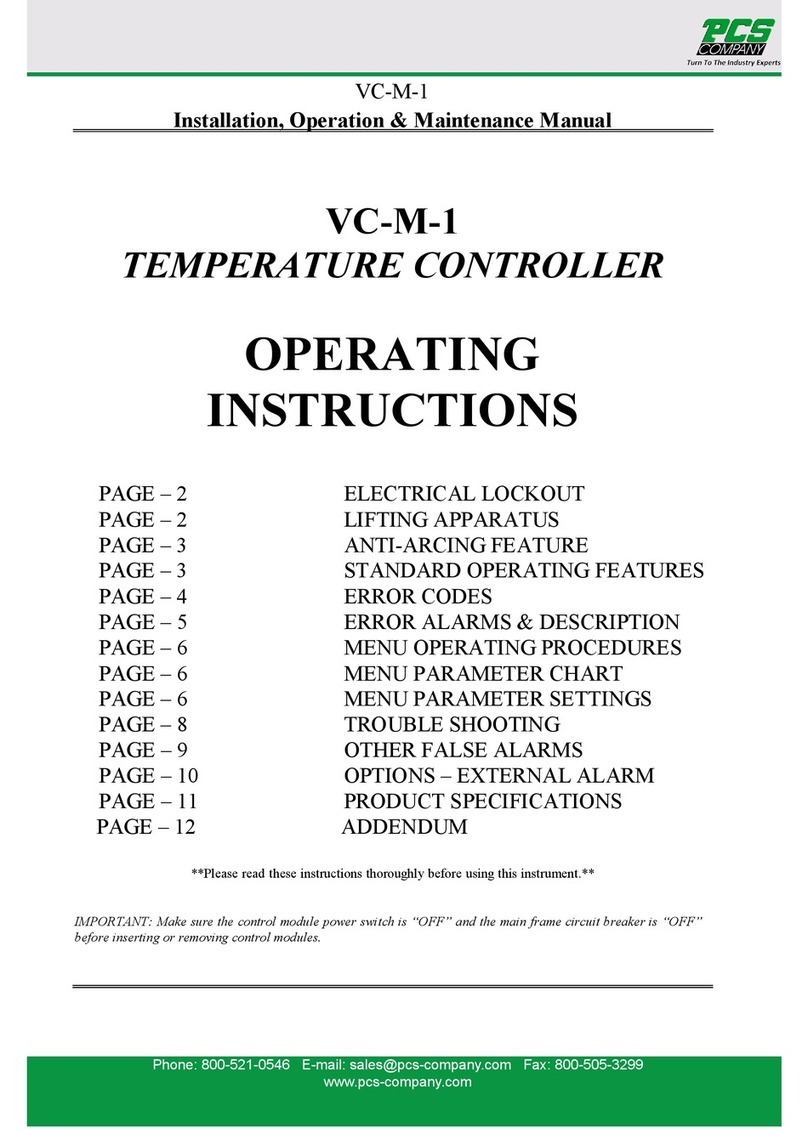
PCS
PCS VC-M-1 Installation, operation & maintenance manual
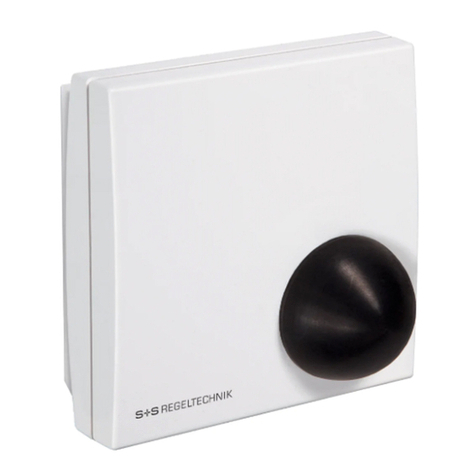
S+S Regeltechnik
S+S Regeltechnik THERMASGARD RSTF Operating Instructions, Mounting & Installation
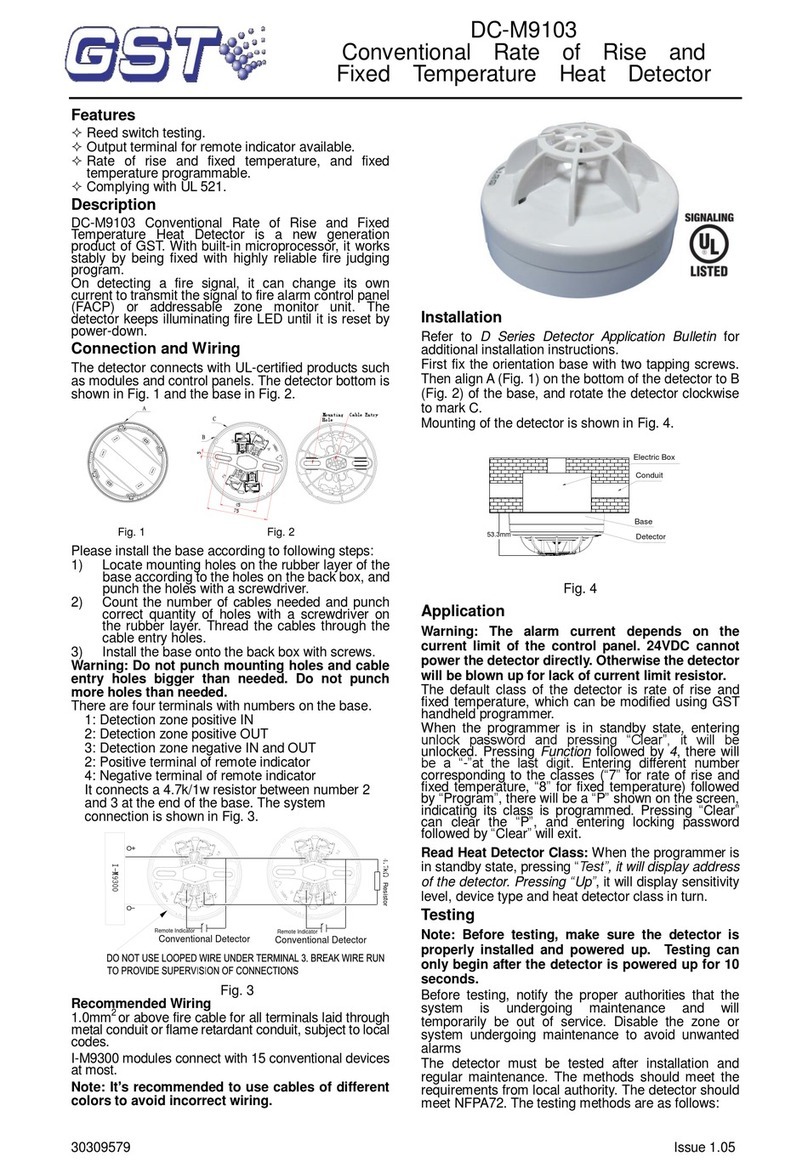
GST
GST DC-M9103 user manual
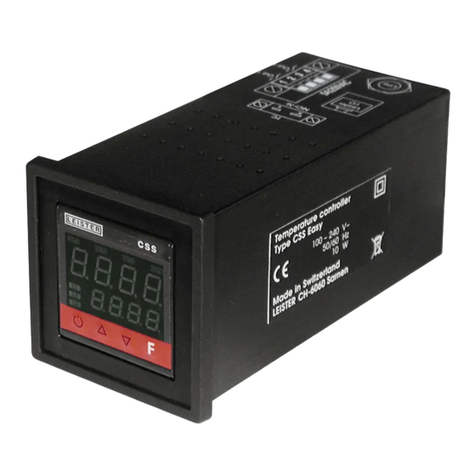
Leister
Leister CSS operating instructions
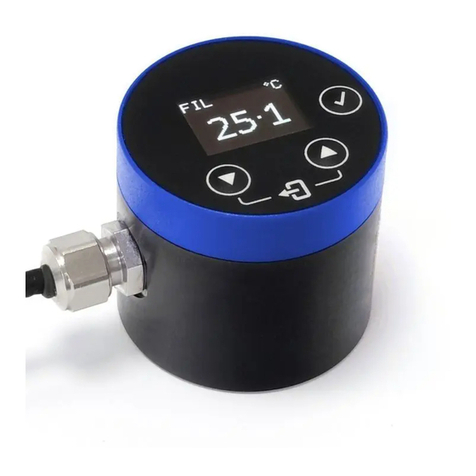
Calex
Calex PyroSigma Series Operator's guide

Lake Shore Cryotronics
Lake Shore Cryotronics Cernox CX-10XX-BO Instruction
